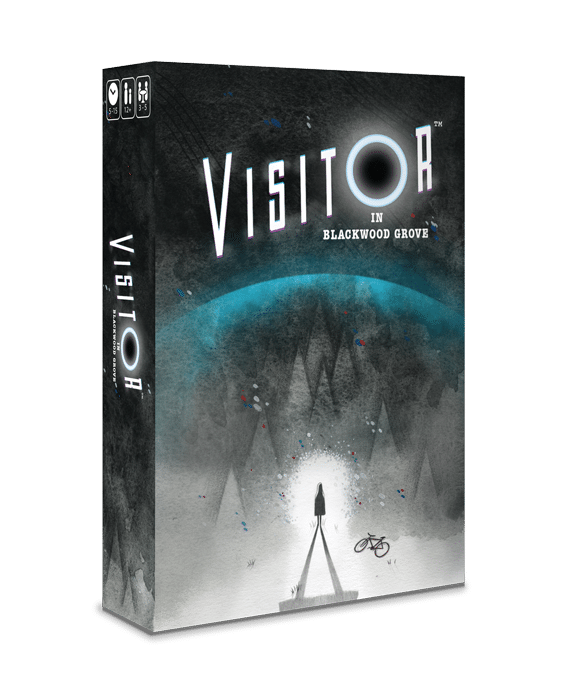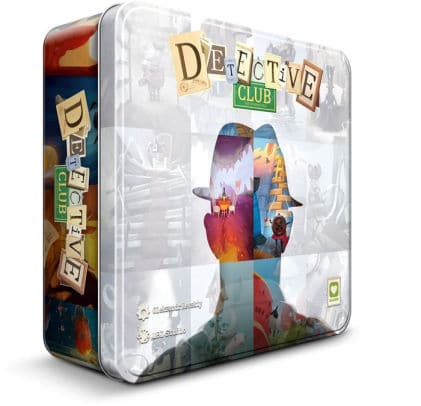I’ve recently played and fallen in love with a number of tabletop games whose primary mechanics and components center around cards featuring pictures and not one tittle of text. In one such game, the picture is of a single object, while the others display whimsical, even nonsensical scenes that conjure up words like “dreamscapes,” “fantasy,” and “surrealism.”
All of them are easy to teach and play, but present varying degrees of challenge and complexity. I’ll start off the showcase with the two simpler offerings before pitching the titles that are a teensy bit more involved.
Visitor In Blackwood Grove

Visitor in Blackwood Grove is a two versus many card game in which a “visitor” (read: alien) finds itself on earth and surrounds itself with a forcefield. Only objects with certain qualities (“Things I can eat,” “Things that weigh more than 100lbs,” “Things with strings,” etc) can pass through the forcefield, and the alien is trying to make the rule obvious to one other player, the kid, while a team of government agents race to sort it out on their own.
The first to correctly identify the rule wins, and the game has a built in timer of 7 turns, so play can take as little as 10 minutes.
Players must use inductive reasoning to pass items from a hand of cards through the forcefield. The visitor will indicate which items satisfy the rule and which are repelled by the shield. Both the visitor and the government agents have means of keeping certain items secret in an attempt to advantage or disadvantage the kid respectively.
Super quick to setup, teach, and play!
Read the full rulebook for Visitor in Blackwood Grove here, and snag yourself a copy from Amazon if it suits your fancy! It makes for a great filler game, for sure.
Dixit
In Dixit, one player at the table chooses a card from their hand and, without showing it to anyone, provides a clue to the whimsical picture on its face. The clue can be a word, a phrase, a song – anything! All other players then submit a card facedown from their own hand which they believe reflects the given clue.
The clue giver then shuffles all of the cards and places them face up above a board (which also conveniently displays turn order, scoring rules, and current scores). All other players (excluding the clue giver) place a token facedown on the table indicating which of the cards they believe to belong to the clue giver. Once all votes are in, they are revealed and the clue giver indicates which card was his or hers.
The clue giver doesn’t want to provide a clue that is super obvious or so vague as to be completely useless, because if everyone or absolutely no one correctly identifies their card they score zero points. However, if at least one player identifies the clue giver’s card but not everyone does, he or she will score 3 points along with anyone who correctly identified the card. Players will also score 1 point anytime their card is incorrectly identified by others as the clue giver’s card!
The game ends when anyone reaches 30 total points or if you run out of cards.
Unlike Visitor in Blackwood Grove but very much like the other titles on this list, Dixit’s card art is zany and leans towards the abstract which allows for a lot of creativity when it comes to clue generation! It, too, is super easy to teach and play. Both it and Visitor can work really well with the younger crowds.
Read the full rulebook for Dixit here and add the game to your library today!
Detective Club

Detective Club is a slightly more complex version of Dixit. Players will take turns being the Active Player, who examines their hand of six cards and chooses a word that describes or applies to two of those cards. One of the two cards is played face up in the middle of the table for all to see.
He or she then takes in hand a number of small notepads equal to the number of other players and writes the secret word in all but one of them. They are then distributed. Every player must then play a total of two cards face up (one at a time on their turn as it passes around the table) that corresponds with the word…only one of the players has no idea what that word is! They must do their best by monitoring the Active Player’s and other players’ cards as they’re revealed!
Once everyone has two face up cards in front of them, the Active Player reveals the word and explains how his or her two cards relate to it. Every player at the table then does the same, and the player who did not receive the word has to think quick and lie like a champ to obscure the fact that they were in the dark the whole time.
Each player, excluding the Active Player, then votes for who they think did not have the word on their notepad. If one or fewer players correctly identify the liar, the liar scores 5VP and the Active Player scores 4. If 2 or more guess correctly, then the liar and the Active Player score 0 points and anyone who correctly identified the liar gets 3VP.
Similar to Dixit, your clue is key! The clue has to be simple enough for the person who doesn’t have the word to sort it out and cover their tracks or the Active Player won’t score any points! It smacks of secret identity games like Spyfall, and is definitely a fun party-styled game with very little downtime and lots of conversation.
Read the rules here and buy a copy from Amazon here.
Mysterium
While there are some cooperative elements to both Visitor in Blackwood Grove and Detective Club, Mysterium is a wholly cooperative game in which players must work together to identify a ghost’s killer, place of death, and the killer’s weapon of choice by deciphering cryptic clues provided by the ghost in the form of the cards of whimsical art we’ve now grown very familiar with.
The ghost has a unique set of people, places, and objects for each player behind his or her screen and uses vision cards to lead each player to the appropriate choice for each. Once all players have received their vision cards, they use a token to indicate their guess based on the vision cards given and the ghost indicates whether or not they were correct in their guess. A correct guess of the person allows them to receive visions for the place, and a correct guess of the place to the object.
The players only have 7 turns to identify their combination of person/place/object and score extra “clairvoyancy” for any remaining turns left in the game once they’re done. They’re then free to help the others sort out their clues; something they’re free to do the whole game, really.
After the 7 turns are up or after all of the players have correctly deduced their clues, the ghost then plays three more vision cards that will clue the other players in to which of the person/place/object groupings reflects the truth! Players are able to look at 1-3 of those cards depending on their clairvoyancy rating and must vote on a grouping without discussing it with the other players.
If the correct grouping is selected by a majority of the players, they win! Otherwise they lose and the ghost continues in its unrest.
Definitely a bit more complex than any of the other titles on the list, but the cooperative element eases some of that pain as players can share and discuss almost all of the information presented in the game to work towards a shared win.
The abstract art on the vision cards prevents most clues from being “gimmes;” there will definitely be some imaginative justifications from the ghost in the end!
Read the full rulebook here and scare up a copy from Amazon here!
It’s really cool to see a very similar mechanic applied to such a wide range of gaming applications and flavors! Whether you’re looking for a simple filler or a more involved game night featured title, one of these visual games is sure to please.

